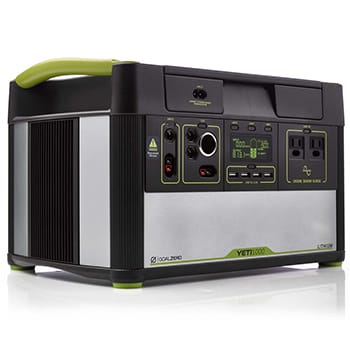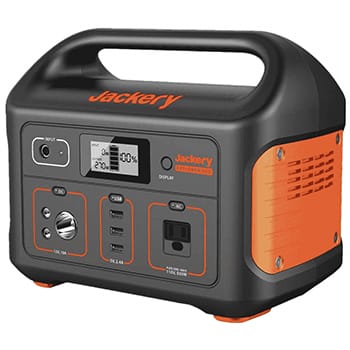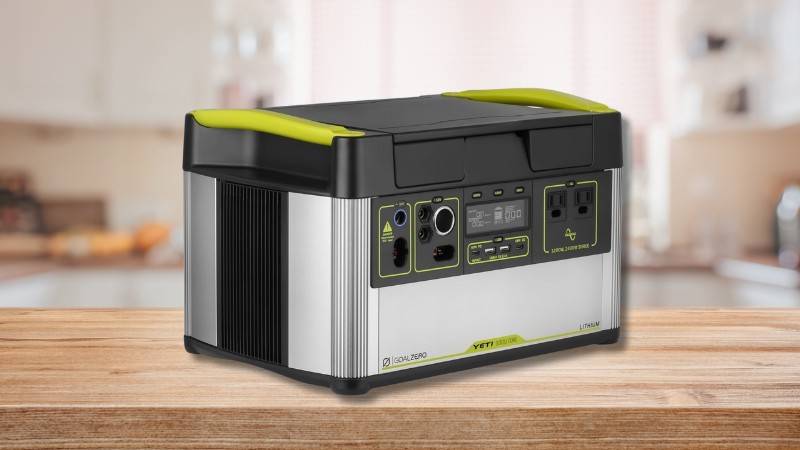Recently, I’ve been in the market for a power station to take on road trips with me. Being a nature fan, I like to get out into the great outdoors from time to time, but I still need something to charge my phone, laptop, lights, and a few other essentials.
I also like having backup power at home, just in case there’s a blackout.
With these needs in mind, I decided to try out the Goal Zero Yeti 1000 Lithium portable power station. While the $1,200 price tag didn’t thrill me, the Pure Sine Wave Inverter with 3000W surge power piqued my interest, as well as the solar panel charging capabilities.
What is the Goal Zero Yeti 1000?

The Goal Zero Yeti 1000 Lithium portable power station is a large portable power station that can be used for backup power in the home or outdoors camping trips, though its 40 lb weight and large size make it more suitable for backup home power in my opinion.
You don’t wanna lug 40 lbs around a muddy campsite.
The Yeti 1000 Lithium comes with 1,084 watt-hours of usage, and the lithium-ion battery can handle 500 cycles of charging up to 80% capacity, so I’ve found that it’s fairly long-lasting if I’m not using it too much.
Like many portable power stations, the Yeti 1000 portable power station can power many things, from refrigerators to power tools and more. It was able to run all my devices on a camping trip and keep a couple of my larger appliances going (laptops, refrigerators, TV) whenever the power in my area goes out for a few hours.
You can charge the Yeti 1000 portable power station with solar panels or AC outlets (wall outlets). Unless you pay to upgrade, you cannot currently charge it from a DC 12V car charger, which is annoying.
Here are some key features of the Yeti 1000 Lithium portable power station:
- 1,084wh Lithium-Ion Battery (10.8V, 96.8Ah)
- Light-Up Digital Screen With Key Information
- 500 Charge Cycles to 80% capacity
- 1500W AC Pure Sine Wave Inverter
- 3000W Surge Inverter
- 2 x AC outlets
- 1 x DC (12V) outlet
- 4 x USB outlets (12W max)
- 200W Solar Panel Charging (Anderson Pole or 8mm Input)
There’s definitely a lot to rave about with the Yeti 1000 Lithium, and it’s great for powering lots of devices from lights to laptops and even mini ovens. I took this on a camping trip once and powered the “Hot Logic Mini” oven which helped me to make pizza in the middle of a forest.
How Long Will A Goal Zero Yeti 1000 Last?
The Yeti Goal Zero 1000 has a shelf life of around 3-6 months, so you need to make sure that you’re using it fairly regularly. It lasts up to 500 life cycles with 80% battery capacity.
When it comes to discharging, the LCD screen lets me see exactly how many hours my battery has left at its current usage with the push of a button. Depending on what my input and output levels are at the time, the “hours left” changes accordingly. Very handy.
What Can A Yeti 1000 Power?
A Yeti 1000 Lithium is powerful enough to power basically anything you would take on a camping trip, giving you power at the push of a button. During a home blackout, it was also powerful enough to power my refrigerator or my TV for a few hours.
How Do You Charge A Goal Zero Yeti 1000?
You can charge a Goal Zero Yeti 1000 through AC outlet charging, which takes around 18 hours to fully charge.
The greener option is solar charging with a solar panel kit, which takes 8-20 hours to fully charge depending on weather conditions.
How Much Does A Goal Zero Yeti 1000 Lithium Cost?
The Goal Zero Yeti 1000 Lithium costs around $1,200 USD.
Goal Zero Yeti 1000 Benefits
It Packs In The Power
If other power stations haven’t quite cut it for you in terms of raw power, then the Yeti Lithium 1000 might be just what you need.
With over 1000 (1,084) watt-hours of power, you can run larger devices like fridges and microwaves on this thing.
However, you pay for that with the hefty size and 40lb weight.
It’s Easy To Use For Newbies
If you’re new to power stations or you just want to go camping and you don’t have much interest in how all this electric stuff works then the Yeti 1000 is a good choice.
You don’t really need to know too much to use this thing — just charge it up, turn it on, and get power at the push of a button.
It clearly tells you how much juice you’re using and how many hours you have left till it runs out, so you don’t need to be doing any complex math equations in your head.
It’s Pretty Quiet
This power station has a couple of cooling fans on either side that help to regulate the temperature.
Despite the fans, you don’t actually hear much noise at all. I found this to be good for peaceful camping trips, though there’s still a slight hum.
Goal Zero Yeti 1000 Shortfalls
Bad Charge Efficiency
The Yeti 1000 takes around 18 hours to fully charge from an AC outlet, and anywhere from 8-20 hours to charge in good solar conditions.
This isn’t particularly good, so I ran a little test.
My tools measured that I was supplying the Yeti with 170 watts of input from my solar panels, but the Yeti itself was only registering 90 watts of this 170 watts. That’s a terrible conversion loss of 43%.
Now I understand that some energy will always be lost in conversion, but losing NEARLY HALF of the solar charge is just not good.
As a green citizen, I’d prefer to use solar power, but the Yeti 1000 really puts me off doing it now. I don’t have an eternity to spend.
Rip-off Add-ons
Considering the steep $1,200 price tag, the Yeti 1000 doesn’t come with an Anderson Pole connector or an 8mm plug for connecting solar panel kits — these need to be purchased separately.
That’s annoying in itself, but to buy these accessories from Yeti separately will cost you upwards of an additional $50. If I wanted to buy a lot of items, I would have built a DIY solar generator instead.
Quite frankly, that’s a shameless cash-grab.
If you’re interested in solar energy like I am, they don’t make it easy (or cheap) for you.
It’s Huge
At a hefty 40 lbs, the Yeti 1000 definitely isn’t the smallest portable power station in the world.
Now obviously the weight is due to the large power output, which is fair enough, but it means that this device isn’t ideal for camping and outdoor trips.
I originally bought the Yeti 1000 for camping, but I ended up retiring it as my backup power supply for my house instead.
40 lbs were just too heavy to be lugging around muddy fields and forests, especially if I was on my own. I’m not Hercules.
No DC Charging Included
Continuing the Yeti theme of not including stuff that many users would want… the Yeti 1000 also doesn’t come with DC (12V) charging capabilities, meaning you can’t charge it from your car as standard.
It also doesn’t come with an MPPT Charge Controller included, which is annoying.
You can buy these things separately if you want to use them as part of your experience, but it’ll cost you a pretty penny for sure.
Pros and Cons Summary of the Goal Zero Yeti 1000
Pros
Cons
- Easy to use for beginners
- Pretty quiet cooling fans
- High power output capabilities
- Expensive $1,200 price tag
- 40 lbs is very heavy
- Inefficient solar charging
- No DC charging included
- 18 hours to fully charge with AC input
- Add-ons are overpriced
Read my reviews of other solar generators:

Things To Consider Before Buying A Portable Solar Generator
Weight & Size
A bigger battery can hold more power, but that advantage is pointless if the power station becomes too big and heavy to easily move around anywhere.
While some manufacturers might call a 40 lb battery a “portable power station,” it’s not exactly easy to move around, especially if you’re on your own with no one to help.
If you’re just using a portable power station as backup power for your home in the event of a blackout, then the size and weight won’t matter… but if you plan to take one of these things camping, you’d better start hitting the gym.
Charging Efficiency
Even if they’re really well-built, some portable power station devices just take absolutely ages to charge up fully.
While you can expect charging with solar panels to take a while depending on weather conditions, some units can take a FULL DAY to fully charge via wall outlet.
Now, you might not need a power station that charges up super quickly, which is fair enough. However, if you’re using the power very often, time may be of the essence to you.
Price
If you can build your own portable power station by buying a separate AC inverter, lithium-ion battery, and the other parts, then it may be cheaper to do so.
Branded portable power stations don’t tend to be cheap, so bear that in mind.
Heat Management
Believe it or not — portable power stations can get very hot.
After all, these are basically just huge batteries producing power. A lot of that energy gets converted to heat, so portable power stations often require cooling fans to keep them running.
These fans can be super loud and annoying.
As well as loud fans, you need to consider whether the battery can run in your climate. If you live in a very hot part of the country, there’s always the chance that the power station could overheat and stop working.
Frequently Asked Questions (FAQ)
You can use Goal Zero Yeti products while charging, yes. The LCD screen will tell you how much power is going into the battery versus how much power is leaving the battery. This helps you to keep track of your power consumption while the device is charging.
If you need to reset your Zero Yeti Goal, simply press and hold the 3 “Units,” “Light,” and “Info” buttons below the display screen and hold them all in simultaneously for a few seconds. After a few seconds, the screen will go off and the Yeti will start to reset itself.
Goal Zero products are designed and engineered in Utah, USA, and then manufactured in a factory in China.
Any 200W solar panel kit that’s specifically designed to charge portable power stations with all the proper cables and inputs/outputs are compatible with Goal Zero.
No, you cannot use a Goal Zero battery to jumpstart a car — the power needed is just too much. Ideally, you need jumper cables and another vehicle to get the battery going again.
The Goal Zero Yeti 1000: Should You Buy It?

So, should you buy the Goal Zero Yeti 1000 Lithium? In my opinion, no.
Yes, it might be able to run power tools and fridges for a while, and yes it might have a pure sine wave inverter… but it’s expensive, heavy, and requires a bunch of add-ons that Goal Zero rips you off for.
Instead, I would recommend the Jackery Explorer 500, especially if you’re using it for camping and outdoor trips. While it has less power, it’s much lighter and smaller (17 lbs), coming with a carry handle and built-in LED flashlight that are perfect for camping trips.
If you need more power or you’re in the market for a backup generator, I’d suggest trying the 500’s bigger brother — the Jackery Explorer 1000 instead.
Not only are these power stations quiet and light, but they come with the features you need and Jackery doesn’t charge you a fortune for its accessories like Goal Zero does.
The Jackerys can also operate in high heat, so they’re brilliant for stuffy tents and hotter climates too.

